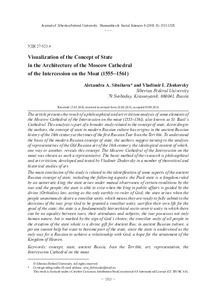Показать сокращенную информацию
Visualization of the Concept of State in the Architecture of the Moscow Cathedral of the Intercession on the Moat (1555–1561)
| Автор | Ситникова, Александра | |
| Автор | Vladimir I. Zhukovsky | |
| Дата внесения | 2019-07-01T07:21:50Z | |
| Дата, когда ресурс стал доступен | 2019-07-01T07:21:50Z | |
| Дата публикации | 2018-09 | |
| Библиографическое описание | Ситникова, Александра. Visualization of the Concept of State in the Architecture of the Moscow Cathedral of the Intercession on the Moat (1555–1561) [Текст] / Александра Ситникова, Vladimir I. Zhukovsky // Журнал Сибирского федерального университета: Гуманитарные науки. — 2018. — Т. 11 (№ 9). — С. 1513-1528 | |
| URI (для ссылок/цитирований) | http://journal.sfu-kras.ru/series/humanities | |
| URI (для ссылок/цитирований) | https://elib.sfu-kras.ru/handle/2311/110519 | |
| Аннотация | The article presents the result of a philosophical and art criticism analysis of some elements of the Moscow Cathedral of the Intercession on the moat (1555–1561), also known as St. Basil’s Cathedral. This analysis is part of a broader study related to the concept of state. According to the authors, the concept of state in modern Russian culture has origins in the ancient Russian history of the 16th century at the times of the first Russian Tsar Ivan the Terrible. To understand the basis of the modern Russian concept of state, the authors suggest turning to the analysis of representatives of the Old Russian art of the 16th century, the ideological content of which, one way or another, reveals this concept. The Moscow Cathedral of the Intercession on the moat was chosen as such a representative. The basic method of the research is philosophical and art criticism, developed and tested by Vladimir Zhukovsky in a number of theoretical and historical studies of art. The main conclusion of the study is related to the identification of some aspects of the ancient Russian concept of state, including the following aspects: the Pusk state is a kingdom ruled by an autocratic king, the state arises under mutual observance of certain conditions by the tsar and the people; the state is able to exist when the king in public affairs is guided by the divine (Orthodox) law, acting as the only earthly co-ruler of God; the state arises when the people unanimously desire a conciliar unity, which means they are ready to fully submit to the decisions of the tsar, pray God to be granted a conciliar unity, sacrifice their own life for the good of the state; the state is a fundamentally hierarchical socio-centric unity in which there can be no equality between tsars, their attendants and subjects; the tsar possesses not only human nature, but is marked by the sign of God’s choice; the conciliar unity of all people in the creation of the state whole is a divine gift for Ancient Rus; in ancient Russian culture, a person cannot help but want to become part of the state, since the state is understood as the only way for a Russian to achieve a relationship with God, a hope for the attainment of the Kingdom of Heaven. | |
| Тема | concept | |
| Тема | state | |
| Тема | ancient Russia | |
| Тема | Ivan the Terrible | |
| Тема | art | |
| Тема | representation | |
| Тема | the Intercession Cathedral on the moat | |
| Название | Visualization of the Concept of State in the Architecture of the Moscow Cathedral of the Intercession on the Moat (1555–1561) | |
| Тип | Journal Article | |
| Тип | Journal Article Preprint | |
| Страницы | 1513-1528 | |
| ГРНТИ | 18.07.21 | |
| Дата обновления | 2019-07-01T07:21:50Z | |
| Институт | Гуманитарный институт | |
| Подразделение | Кафедра культурологии | |
| Журнал | Журнал Сибирского федерального университета | |
| Квартиль журнала в Scopus | без квартиля |

